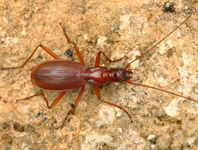Abstract
The spotted bumblebee shrimp Gnathophyllum elegans (Risso, 1816) is a caridean species of the family Palaemonidae Rafinesque, 1815 widely distributed in the eastern Atlantic and the entire Mediterranean Sea (Zariquiey Alvarez 1968; d’Udekem d’Acoz 1999; De Grave et al. 2015). It is a solitary sciaphilous taxon that grows up to 40 mm of total length, and at daytime hides under stones, in crevices or amidst Posidonia oceanica (Linnaeus) Delile rhizomes from the intertidal to about 30 m depth, with some authors even considering it as preferring coralligenous environments (Pérès & Picard 1964; Ledoyer 1968; d’Udekem d’Acoz 1999). Such a cryptic behavior makes the detection of G. elegans often difficult in the field, although the species is easily distinguishable by the other eastern Atlantic-Mediterranean shrimp species due to its colourful appearance and mostly due to its dark purple-brown body entirely covered by yellow-orange dots (Zariquiey Alvarez 1968; Falciai & Minervini 1992).
References
Calado, R. (2006) Marine ornamental species from European waters: a valuable overlooked resource or a future threat for the conservation of marine ecosystems? Scientia Marina, 70 (3), 389–398.
https://doi.org/10.3989/scimar.2006.70n3389
Calado, R. (2008) Marine ornamental shrimp: biology, aquaculture and conservation. Wiley-Blackwell, New Jersey, 271 pp.
De Grave, S., Fransen, C.H.J.M. & Page, T.J. (2015) Let’s be pals again: major systematic changes in Palaemonidae (Crustacea: Decapoda). PeerJ, 3, e1167.
https://doi.org/10.7717/peerj.1167
d’Udekem d’Acoz, C. (1999) Inventaire et distribution des crustacés décapodes de l’Atlantique nord-oriental, de la Méditerranée et des eaux continentales adjacentes au nord de 25 N. Collection des Patrimoines Naturels, 40, 1–383.
Elias, M.A.M., Anker, A. & Gawryszewski, F.M. (2019) Microhabitat use and body size drive the evolution of colour patterns in snapping shrimps (Decapoda: Alpheidae: Alpheus). Biological Journal of the Linnean Society, 128, 806–816.
https://doi.org/10.1093/biolinnean/blz152
Falciai, L. & Minervini, R. (1992) Guida dei crostacei decapodi d’Europa. Franco Muzzio, Padova, 300 pp.
Gonzalez Pérez, J.A. (1995) Catalogo de los crustaceos decapodos de las Islas Canarias. Gambas. Langostas. Cangrejos. Publicaciones Turquesa S.L., Santa Cruz de Tenerife, 282 pp.
Ledoyer, M. (1968) Ecologie de la faune vagile des biotopes méditerranéens accessibles en scaphandre autonome (Région de Marseille principalement) IV.—Synthèse de l’étude écologique. Recueil des Travaux de la Stations Marine d’Endoume, 44 (60), 125–295.
Manning, R.B. (1963) The East American Species of Gnathophyllum (Decapoda, Caridea), with the Description of a New Species. Crustaceana, 5 (1), 47–63.
https://doi.org/10.1163/156854063X00057
Meyer, R., Lehmann, T., Melzer, R.R. & Geiselbrecht, H. (2014) Morphology of the first zoeal stage of the Mediterranean bumblebee shrimp Gnathophyllum elegans (Risso, 1816) studied with light microscopy and scanning EM. Journal of the Marine Biological Association of the United Kingdom, 94 (1), 151–158.
https://doi.org/10.1017/S002531541300115X
Pérès, J.-M. & Picard, J. (1964) Nouveau manuel de bionomie benthique de la Mer Méditerranée. Recueil des Travaux de la Stations Marine d’Endoume, 31 (47), 1–137.
Wirtz, P. (1997) Crustacean symbionts of the sea anemone Telmatactis cricoides at Madeira and the Canary Islands. Journal of Zoology, 242 (4), 799–811.
https://doi.org/10.1111/j.1469-7998.1997.tb05827.x
Wirtz, P. & Debelius, H. (2003) Mediterranean and Atlantic invertebrate guide. Conchbooks, Hackenheim, 305 pp.
Zariquiey Alvarez, R. (1968) Crustáceos Decápodos Ibéricos. Investigación Pesquera, 32, i–xv + 1–510.


